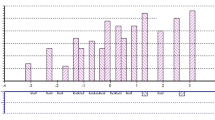Abstract
The Multidimensional Pain Inventory (MPI) is one of the most commonly used self-report instruments in pain settings. The MPI can be used to classify patients into three clusters or its nine scales can be treated as dimensions in efforts to understand patient heterogeneity. Previous research suggests the existence of a fourth cluster, whose members have been labeled ‘repressors,’ that emerges with the addition of a defensiveness scale to the MPI. The current paper compared the abilities of MPI cluster and dimensional models with and without a measure of defensiveness to capture variability in validating variables related to personality, psychopathology, physical functioning, and treatment outcome in a chronic pain sample. Results suggest that dimensional models consistently outperform cluster models in explaining variance in outcome variables, and that the addition of a measure of defensiveness increments the validity offered by the MPI scales. Implications for the assessment of pain patients are discussed.
Similar content being viewed by others
Notes
It should be noted that defensiveness and repression are overlapping, though not identical concepts. For the purpose of this paper, repressor denotes a person with suppressed scores on indicators of psychological distress but elevated scores on measures of somatic distress, whereas defensiveness indicates a more general pattern of suppressed scores on distress indicators. Nevertheless, the current research follows previous efforts in using defensiveness scales to identify repressors in pain samples.
References
Blashfield, R. K. (1993). Variants of categorical and dimensional models. Psychological Inquiry, 4, 95–98. doi:10.1207/s15327965pli0402_3.
Breuer, F., & Freud, S. (1895). Studien über hysterie. Leipzig and Vienna: Franz Deuticke.
Burns, J. W. (2000). Repression predicts outcome following multidisciplinary treatment in chronic pain. Health Psychology, 19, 1–10. doi:10.1037/0278-6133.19.1.75.
Burns, J. W., Kubilus, A., Bruehl, S., & Harden, R. N. (2001). A fourth empirically derived cluster of chronic pain patients based on the Multidimensional Pain Inventory: Evidence for repression within the dysfunctional group. Journal of Consulting and Clinical Psychology, 69, 663–673. doi:10.1037/0022-006X.69.4.663.
Edens, J. F., & Ruiz, M. A. (2006). On the validity of validity scales: The importance of defensive responding in the prediction of institutional misconduct. Psychological Assessment, 18, 220–224. doi:10.1037/1040-3590.18.2.220.
Fairbank, J. C. T., Couper, J., Davies, J., & O’Brien, J. P. (1980). The Owsestry Low Back Pain Questionnaire. Physiotherapy, 66, 271–273.
Fairbank, J. C. T., & Pynsent, P. B. (2000). The Owsestry Disability Index. Spine, 25, 2940–2953. doi:10.1097/00007632-200011150-00017.
Jamison, R. N., Rudy, T. E., Penzien, D. B., & Mozley, T. H., Jr. (1994). Cognitive behavioral classifications of chronic pain: Replication and extension of empirically derived patient profiles. Pain, 57, 277–292.
Kerns, R. D., Turk, D. C., & Rudy, T. E. (1985). The West Haven-Yale Multidimensional Pain Inventory. Pain, 23, 345–356. doi:10.1016/0304-3959(85)90004-1.
Kopec, J. A., Esdaile, J. M., Abrahamowicz, M., Abenhaim, L., Wood, D. S., Lamping, D. L., et al. (1996). The Quebec Back Pain Disability Scale: Conceptualization and development. Journal of Clinical Epidemiology, 49, 151–161. doi:10.1016/0895-4356(96)00526-4.
Landis, J. R., & Koch, G. G. (1977). The measurement of observer agreement for categorical data. Biometrics, 33, 159–174. doi:10.2307/2529310.
Morey, L. C. (1991). Professional manual for the Personality Assessment Inventory. Odessa, FL: Psychological Assessment Resources.
Morey, L. C., Blashfield, R. K., & Skinner, H. A. (1983). A comparison of cluster analysis techniques within a sequential validation framework. Multivariate Behavioral Research, 18, 309–329. doi:10.1207/s15327906mbr1803_4.
Paulhus, D. L. (1984). Two-component models of socially desirable responding. Journal of Personality and Social Psychology, 46, 598–609. doi:10.1037/0022-3514.46.3.598.
Paulhus, D. L. (2002). Socially desirable responding: The evolution of a construct. In H. Braun, D. N. Jackson, & D. E. Wiley (Eds.), The role of constructs in psychological and educational measurement (pp. 67–88). Hillsdale, NJ: Erlbaum.
Paulhus, D. L., & John, O. P. (1998). Egoistic and moralistic biases in self-perception: The interplay of self-deceptive styles with basic traits and motives. Journal of Personality, 66, 1025–1060. doi:10.1111/1467-6494.00041.
Piotrowski, C. (1998). Assessment of pain: A survey of practicing clinicians. Perceptual and Motor Skills, 86, 181–182.
Reynolds, W. M. (1982). Development of reliable and valid short forms of the Marlowe-Crowne Social Desirability Scale. Journal of Clinical Psychology, 38, 119–125. doi:10.1002/1097-4679(198201)38:1<119::AID-JCLP2270380118>3.0.CO;2-I.
Turk, D. C., & Rudy, T. E. (1988). Toward an empirically derived taxonomy of chronic pain patients: Integration of psychological assessment data. Journal of Consulting and Clinical Psychology, 56, 233–238. doi:10.1037/0022-006X.56.2.233.
Ward, J. H. (1963). Hierarchical grouping to optimize an objective function. Journal of the American Statistical Association, 58, 236–244. doi:10.2307/2282967.
Ware, J. E., Jr., Kosinski, M., & Keller, S. D. (1995). SF-12: How to score the SF-12 Physical and Mental Health Summary Scales (2nd ed.). The Health Institute, New England Medical Center.
Widiger, T. A., & Samuel, D. B. (2006). Diagnostic categories or dimensions? A question for the Diagnostic and Statistical Manual of Mental Disorders–Fifth Edition. Journal of Abnormal Psychology, 114, 494–504. doi:10.1037/0021-843X.114.4.494.
Author information
Authors and Affiliations
Corresponding author
Rights and permissions
About this article
Cite this article
Hopwood, C.J., Creech, S.K., Clark, T.S. et al. Optimal Scoring of the Multidimensional Pain Inventory in a Chronic Pain Sample. J Clin Psychol Med Settings 15, 301–307 (2008). https://doi.org/10.1007/s10880-008-9131-x
Received:
Accepted:
Published:
Issue Date:
DOI: https://doi.org/10.1007/s10880-008-9131-x




